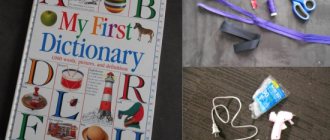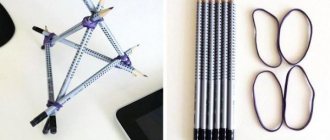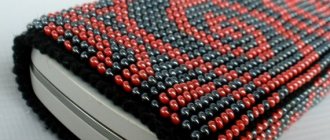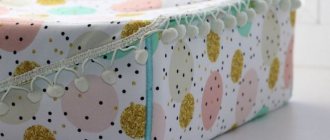Today, hardly anyone has problems purchasing a laptop case. Go to any store that sells these devices, and the sellers will be happy to offer you many beautiful and high-quality models. However, their price quite often scares off buyers, especially now, when many people are strapped for money during quarantine.
But what to do if you need a cover, but don’t have enough money for it? I suggest you follow my example and sew a beautiful and comfortable case with your own hands. This felt case will cost you much less than a store-bought one. Believe me, this is not difficult to do, of course, if you know how a sewing machine works.
Let me be clear that I was sewing a case for a 12-inch Macbook Pro, but you can easily adjust these instructions to fit any size device.
What you need for work
You need to prepare:
- 45 cm thick felt;
- colored wide elastic band;
- contrast thread;
- scissors;
- sewing pins;
- roulette;
- sewing machine
If all materials and tools are prepared, you can begin to work. Step-by-step instructions are accompanied by photos that will help you understand the sequence of actions.
TV presenter “Let's Get Married” Roza Syabitova told how to avoid divorce
Bad habit: why you can’t drink water from a glass that’s been standing all night
Until the last day she performed on the front line: “The Blue Handkerchief” by Klavdia Shulzhenko
How to make a pattern
Before you start making a pattern, decide on the style of the accessory and the basic parameters. Key issues that need to be addressed:
- handles long or short;
- Are additional pockets needed?
- case size.
The best option for sewing a carrying bag is to use ready-made patterns. By taking measurements from your laptop, you can use them to create your own bag model, changing its configuration, improving it, or coming up with something unique. In this case, during the adjustment process, you need to carefully compare the dimensions of the pattern. Don't forget about seam allowances (on average 18-22 mm).
To start making a pattern, take measurements from a portable device (length, width, height).
Types of patterns:
- Carrying bag with zipper.
- Snaps, Velcro or buttons will be used to secure the cover.
If the cover model does not have a zipper, make one of the panels one third larger. This part of the bag will be used as a lid. Buttons, Velcro or ties are suitable for securing it.
Materials and tools
To work, you will need ready-made quilted fabric. If you don't have it, you can make it yourself. To do this, you need to take a certain amount of fabric for the outer layer, lining and filler (batting, padding polyester, foam). Next, you must take care of a strap (you can also buy it or sew it yourself from fabric), carabiners or two loops and two clasps. You need thread with a needle, pins, chalk, ruler, zipper. It will be great if your sewing machine has a zigzag mode or you use an overlocker.
Sewing algorithm
Step-by-step instructions will help you make a bag for carrying a laptop, even for those who have never sewn anything on their own before. When performing each stage, it is important to be extremely careful and careful. Start sewing from the body, using a regular stitch.
Patch pocket
Pockets are a useful part of the case. In addition to the inner one, make several pieces from the outer part of the case. If you are sewing a carrier from old jeans, do not rip off the pockets.
Patch pockets are made without lining. The corners of the overlay often come off, so it is recommended to additionally stitch them with decorative stitching.
How to make a patch pocket:
- Take a rectangular piece, fold the top part, iron it, stitch it.
- Turn the top edge along the line where the fold passes, stitch along the sides.
- Turn the top edge inside out and iron again.
- Prepare a pocket template from cardboard, not taking into account seam allowances.
- Place the template under the top edge of the pocket. Fold the seam allowances according to the template shape and iron. In square-shaped pockets, fold the seam allowance diagonally.
- Baste the seam allowances. Spread them out evenly. Take out the template and iron the workpiece again.
- Sew a decorative stitch across the top of the overlay.
- Baste the pocket to the front of the bag or pin it in place.
- Sew it with a double stitch. When you apply the second seam, overlap the open edges of the hem.
Secure the inner pocket before stitching the sides.
Sewing the body
Sewing the bag should be done on a sewing machine. Try a few stitches first to make sure it can handle the thick layer of fabric without creating any puffs on the outside of the bag. If the machine does not pull, you will have to work with your hands.
Procedure:
- Place the outer layer pieces facing each other.
- Sew them on 3 sides, remove unnecessary threads, and trim the edges.
- Turn the workpiece inside out, stitch the body from the front side, iron it.
- When stitching the inside of the lid, leave the edges slightly understitched. Later, fold the loose edge of the lid inward and sew it to the lining fabric with neat blind stitches.
- If desired, add decorative stitching to the flap.
- Make the corners of the carrier and make the bottom.
- Insert the corners into the lower part of the sewn part and secure the seam with a bobby pin.
- Measure a length perpendicular to the seam that will correspond to the width of the laptop. Mark the border with a pencil.
- Sew the product along the contour. Experts advise making a double stitch in this place. It will be stronger this way.
- Follow the same procedure with the second corner. The same actions will need to be done with the lining part of the product.
If you plan to decorate the case with applique, embroidery or other decorative details, create now, until all the parts of the carrying case are assembled.
For a model with a zipper on the top, attach the fastener to the front side of the case using pins. To make the zipper fit more tightly to the fabric in the rounded areas, make 5-6 small cuts at a distance of 1 cm from each other. Sew the lock.
Lining
Sewing algorithm:
- Sew the inner parts of the cover together.
- Finish the edges.
Try it on so that the laptop fits freely inside the workpiece.
Padded padding
How to connect the lining with padding polyester:
- Attach the padding polyester pattern to the lining from the outside.
- Use a stitch to connect them around the perimeter.
- To make the parts of the cover one whole, quilt the workpiece.
If there is no clear pattern on the fabric, do it randomly. Just first sketch out exactly what pattern you will use to apply the seams so that the stitching turns out symmetrical.
Assembly
At this stage of production of a carrying device for a portable device, do the following:
- Place the part of the bag that is obtained after connecting the padding polyester and the lining into the outer blank. To make the operation easier, instead of a laptop, place a mock-up of it in the internal blank.
- Adjust the inside of the case so that it protrudes 5 cm above the portable device model.
- In turn, the outer part of the bag should protrude above the edge of the inner shell of the case.
- Lay the fabric so that the unfinished edges of the carrier are hidden under it.
- Insert magnetic buttons: pierce the fabric and straighten the legs. Grab only the outer fabric and lining, leaving the seal intact. Otherwise, the edges of the button will scratch the body of the portable mobile device.
- Make punctures in the lid from the inside. The outer fabric should remain intact so that the mechanism is not visible from the outside.
Fasten and stitch the layers together. Perform all actions from the inside of the product.
Pens
All that remains is to prepare reliable handles for transporting the bag.
Procedure:
- Cut 2 ribbons of at least 10 cm wide from strong fabric. Decide how long the handles are going to be made. If you plan to wear a carrying bag over your shoulder, make the strips at least 70 cm long. For a case with a short handle, strips 30 cm long will be enough.
- Fold the strips so that the right side of the fabric is inside. Sew the handles.
- Turn the tape inside out and divide it into 3 equal parts. For convenience, mark the division points with pins. Attach the edges to the bag and stitch.
The greater the margin of safety of the handles you leave, the more difficult it will be to break them.
Road
The fabric for a travel bag needs to be thick because it is intended for carrying luggage or carry-on luggage. For sewing, burlap or tarpaulin is most often used, from which work clothes are made.
The diagrams show approximate sizes that can be customized according to your wishes.
Pattern for the road model
Tools and materials
To work you will need:
textile;
zipper 60 cm;
nylon threads.
The piece of fabric must be at least 80 cm long and 160 cm wide in order to make allowances and sew in handles.
Step-by-step instruction
Step 1. The fabric is laid out on a pre-cut pattern, the drawing of each part is transferred to it, taking into account the seams.
Step 2. To do this, the sections are folded from the inside (from the zipper) of each part towards the wrong side. Then two loops are sewn between the top part and the part that will be the bottom and walls of the product.
Step 3. Place the two main parts right sides together, stretch a loop between them and machine them. Treat the other side in exactly the same way. After this, turn the workpiece right side out and stitch them again.
Step 4. Now the handles are sewn on. To do this, you need to turn the sections of each part on the wrong side and fold them in half; this all also needs to be processed on all sides. The resulting handles are attached to the worked parts. The distance between the edges of the handles should be calculated based on their length and what the product is intended for.
Step 5. If it is intended to be carried as hand luggage, then the handles are made short and sewn at a large distance, and for a heavy load, it is better to attach the handles close and make them at least 60 cm in length.
Step 6. The last step is to fasten all the finished parts. First, one side wall with a handle sewn in advance is sewn to the workpiece with a zipper, and then the second. If desired, you can insert a hard bottom.
Quilting the base
You need to place the main fabric right side down. Then cover it with padding polyester or batting, and cover it with a second piece of fabric, placing it face up. Pin all three layers around the perimeter. Since the filler strip is slightly smaller than the material and backing, staple where they are still connected. Then machine stitch around the perimeter from the side that is most convenient for you to work with.
After this, use chalk or a piece of soap to draw a pattern with which you want to quilt the material. These can be squares, stripes, diamonds, zigzags or wavy lines. Sew along all marked directions. After this, fold the lining and the main fabric around the perimeter so that they are connected to each other. At the same time, tuck the sides inward, since the edges should be neat.
DIY fabric bags: diagrams, patterns, accessories and a master class on making (115 photos)
Having a lot of different bags in the house for all occasions has always been considered a rule of good manners. In order to make a bag for home use with your own hands, you do not need to have special education or professional skills.
Looking at photos of fabric bags posted on specialized websites will help you choose a style. The source material for a fabric bag will be items of outerwear in the wardrobe, which for a number of reasons are no longer used for the intended purpose of the owner.
These can be jackets made of raincoat fabric or artificial leather, demi-season coats made of drape, jackets made of natural wool. You also need to decide on the intended use, shape and geometric dimensions of the fabric bag.
Brief contents of the review:
Fabric selection
Before you start sewing, you need to decide on the material suitable for the future product. The fabric is selected depending on what model of bag you plan to sew. What is good for an everyday bag or backpack is completely unsuitable for a dressy handbag. Let's try to figure out how to choose the right fabric for sewing.
Textile
Depending on the density of the textile, it can be used to make almost any bag. For example, gabardine, tapestry or denim are perfect for everyday models - these fabrics have increased strength and wear resistance. Cotton or linen are great choices for beach bags; Velvet, velor, jacquard or satin make elegant small handbags for special occasions.
Felt
This material is particularly velvety, soft, light, but at the same time it is quite dense. It produces beautiful and interesting products also due to the fact that working with it is a pleasure: it practically does not wrinkle, does not “creep”, does not fray, which means it does not require additional processing of the seams.
Of course, there are also disadvantages to such a bag - all the dust sticks to the felt very quickly, and it is better to avoid washing this material, it tends to “shrink”. Therefore, it is not very suitable for everyday bags, but it is perfect for “going out” models, since from felt you can sew such original models that cannot be obtained from any other fabric.
Fur and suede
Suede products are characterized, first of all, by their dimensional stability and wear resistance. Suede bags always look expensive and beautiful, so choosing this material for sewing is a win-win option for almost any model.
Fur is the material most often used to decorate products, but it can also be the main material. A fur handbag is a rather original, interesting and modern accessory.
To make such a product, both faux fur and natural fur are used.
From pieces of fur or an old unnecessary fur coat, you can sew an exclusive handbag that will definitely attract attention
Sackcloth
Burlap is an excellent material for sewing a beach bag, travel bag, backpack or shoulder bag. Not so long ago, burlap products came into fashion and today are extremely popular.
They are original, beautiful, durable; suitable for all occasions - you can wear them to work, on vacation, on a visit or just for a walk. Interesting and beautiful decor will make a burlap bag a unique design work and will delight you for a long time.
Other materials
There are many other materials for making a bag with your own hands - the specific choice is strictly individual and depends mainly on the functionality of the future product. The most common option is bags made of artificial or genuine leather. They are universal in use, practical and reliable. You can make any bag from leather - from a small cosmetic bag to a large backpack or suitcase.
Also used for sewing:
- raincoat fabric;
- tarpaulin;
- nylon (polymer materials);
- twill;
- wool;
- thin felt;
- drape;
- twill;
- Condura;
- canvas;
- varnish (glossy artificial leather), etc.
Don't forget about the lining material.
Most often used for this purpose:
- viscose;
- silk;
- polyester;
- satin;
- net;
- taffeta.
The main condition when choosing a lining is that it should be thin, but preferably durable.
Cutting the bags
After making the pattern, start cutting out the bag. Transfer the drawing to the fabric, not forgetting to add a few centimeters for fit. You should end up with 2 parts of the body, lining and seal. Make a mock-up of the patch pocket. The valve design depends on the size of the laptop and its appearance.
If you decide to sew a simple bag, you don’t have to make a pattern:
- Lay out a piece of fabric on the table. Place the laptop on top and take the necessary measurements.
- When cutting the cover, be sure to leave at least 2 cm on the seams. Cut 2 pieces to sew the outer walls of the carrier.
- Using them, cut the blanks for the seal and lining. Here, add no more than 1.5 cm to the seam.
Having decided on the length of the handles, prepare 2 patterns 10-15 cm wide.
A few recommendations for making a laptop carrying case:
- Before you start sewing the cover, steam the cut parts or iron them well. It is easier to work with such material; the components will fit better together.
- An original solution for handles would be braids woven from thick cord and bamboo rings.
- It is not recommended to make handles less than 8 cm wide.
During the bag making process, do a few fittings to make sure everything goes according to plan. The sooner you notice an error, the easier it will be to correct it.
LiveInternetLiveInternet
-Music
—Tags
—Categories
- FELT.Dolls.Toys.Felting (440)
- For children, with children. Our child (365)
- Curtains.Decor.Everything for the bath.Design (347)
- FROM PAPER, newspapers, cardboard. Packaging, boxes, etc. (296)
- Useful tips. Notes for the housewife. Learning to cook (286)
- HEALTH, beauty, psychology, traditional medicine (286)
- Cottage, garden, vegetable garden. FLOWERS (274)
- SCRAPBOOKING, postcards, notepadsParchman technique (232)
- Knitting, weaving, beads, embroidery, etc. (225)
- MODELING. Cold porcelain. Salt dough. Clay. Biscuit. (222)
- Holidays.New Year.Wedding.Decorating the house (180)
- ORGANIZERS, pockets, boards, covers (176)
- KITCHEN. We sew, decorate, decorate. (152)
- HEART-hearts (136)
- Pillows, blankets, bedspreads, rugs (135)
- LAMPS, lampshades, chandeliers. Fireplaces (134)
- Baskets, bags.BAGS (118)
- INTERESTING in the diary (111)
- Knitting.HOOK (102)
- HOUSES (from different materials) (97)
- FENG SHUI.CHURES. (92)
- PANEL, photographs, paintings, wreaths. Wallpaper, avatars (92)
- PATCHWORK.Kinusaiga.Patchwork.Patchwork.Applique (91)
- SOAP, scrub, shampoo (88)
- We sew clothes, shoes and much more. Fashion (80)
- Pincushions, organizers for needles, sewing items (69)
- MAGAZINES, books on needlework, knitting (69)
- FRAMES for photos, paintings, mirrors (66)
- CATS, DOGS and all other little brothers. All about them (65)
- Knitting.Knitting needles (63)
- MUSIC.Poems.Movies.Games (57)
- Videos, gifs (53)
- CDs in the interior. For CDs. And more (49)
- Computer.Mobile,Internet (48)
- Quilling (45)
- LINKS to forums, websites (44)
- Flowers from everything (42)
- Decor of jars, bottles. Crafts from plastic bottles (38)
- Master class.Hand Made.Handicrafts.Crafts from everything (38)
- MOSCOW.RUSSIA (36)
- BUTTERFLIES from everything (34)
- Travel.World (30)
- WEAVING,tapestry (26)
- DECOUPAGE (19)
- mine (9)











